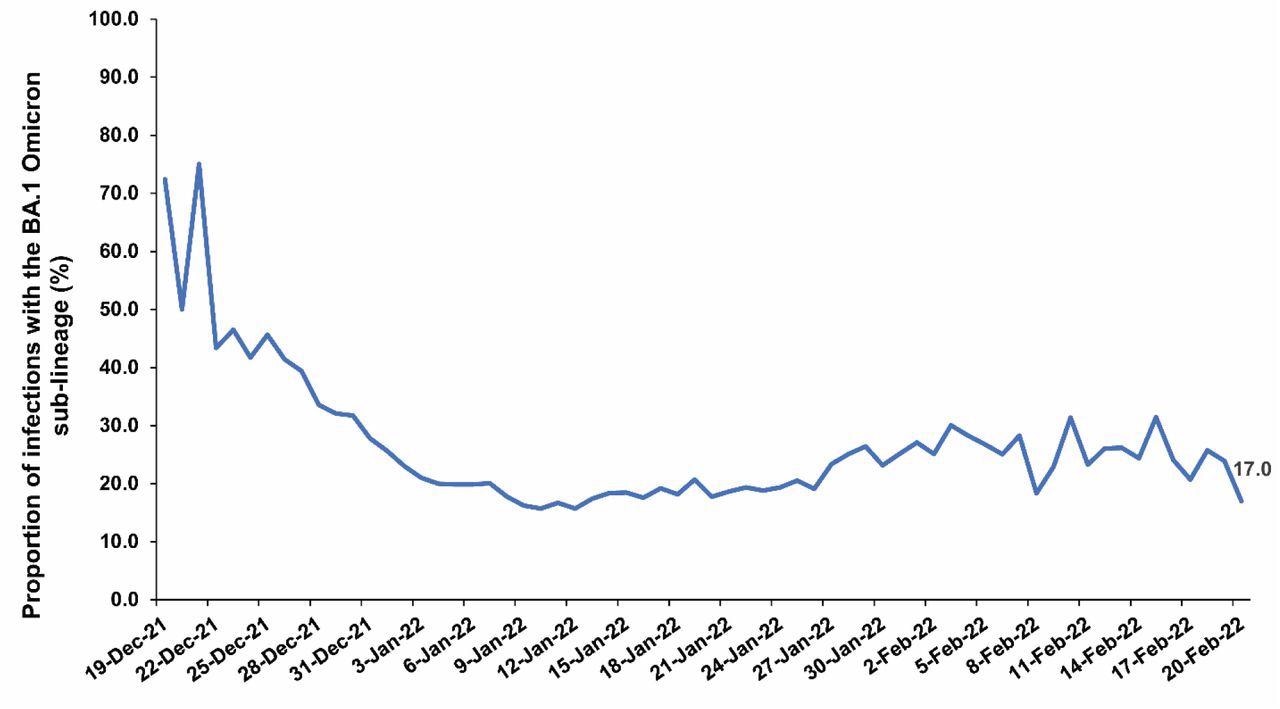 By Neha MathurReviewed by Danielle Ellis, B.Sc.Mar 8 2022
By Neha MathurReviewed by Danielle Ellis, B.Sc.Mar 8 2022In a recent study posted to the medRxiv* pre-print server, researchers evaluated the severity of severe acute respiratory syndrome coronavirus 2 (SARS-CoV-2) Omicron (B.1.1.529) infections between December 23, 2021, and February 20, 2022, in Qatar to understand how Omicron subvariants, vaccination, and prior infection status impacted these cases.
 Study: Effects of BA.1/BA.2 subvariant, vaccination, and prior infection on infectiousness of SARS-CoV-2 Omicron infections. Image Credit: Kuki Ladron de Guevara / Shutterstock
Study: Effects of BA.1/BA.2 subvariant, vaccination, and prior infection on infectiousness of SARS-CoV-2 Omicron infections. Image Credit: Kuki Ladron de Guevara / Shutterstock

 This news article was a review of a preliminary scientific report that had not undergone peer-review at the time of publication. Since its initial publication, the scientific report has now been peer reviewed and accepted for publication in a Scientific Journal. Links to the preliminary and peer-reviewed reports are available in the Sources section at the bottom of this article. View Sources
This news article was a review of a preliminary scientific report that had not undergone peer-review at the time of publication. Since its initial publication, the scientific report has now been peer reviewed and accepted for publication in a Scientific Journal. Links to the preliminary and peer-reviewed reports are available in the Sources section at the bottom of this article. View Sources
Qatar has an exceptionally young and diverse demographics, where only 9% of its residents are over 50 years of age, and 89% are expatriates from over 150 other countries. Unfortunately, starting December 19, 2021, Qatar experienced a resurgence of coronavirus disease 2019 (COVID-19) cases due to Omicron that peaked by the middle of January 2022. During this time, initially, more cases were reported due to Omicron subvariant BA.1, but within a few days, the other subvariant BA.2 became dominant.
During the Omicron pandemic wave, quantitative reverse transcription-polymerase chain reaction (RT-qPCR) testing, performed at a mass scale in Qatar, helped them diagnose 75% of COVID-19 infections. Every RT-qPCR test recorded the reason for testing, such as contact tracing, random testing campaigns, clinical symptoms, individual requests, routine healthcare testing, pre-travel, at the port of entry, or other. Nearly every resident in Qatar was fully vaccinated against COVID-19 during this time, and the Qatar government had all the COVID-19-related information recorded in their health system. Qatar’s federated SARS-CoV-2 databases even had information on vaccinations performed elsewhere at the port of entry upon arrival to Qatar.
About the study
In the current cross-sectional study, researchers used the real-time RT-qPCR cycle threshold (Ct) value as a proxy for SARS-CoV-2 infectiousness to investigate the effects of Omicron infections in all the residents of Qatar who had an RT-qPCR-confirmed SARS-CoV-2 infection during December 23, 2021, and February 20, 2022.
The researchers sourced all the demographic data from Qatar’s national COVID-19 databases, including reported clinical infections, vaccinations, RT-qPCR tests, and related demographic details since the beginning of the pandemic.
They used the TaqPath COVID-19 combo kit for subvariant status - a SARS-CoV-2 infection with the Omicron BA.1 subvariant was proxied as a spike (S)-gene target failure (SGTF) case, and with the BA.2 subvariant was proxied as a non-SGTF case.
For each study participant, the researchers selected the first positive RT-qPCR-confirmed test. Later, they derived the average Ct value (to be used as the dependent variable) by averaging the Ct values of the nucleocapsid (N), open reading frame 1ab (ORF1ab), and S genes.
Overall, they investigated the extent of COVID-19 spread during the study period based on the information of subvariant causing the infection (BA.1 versus BA.2), vaccination type (BNT162b2 or mRNA-1273), vaccination status (doses, time elapsed since vaccination), prior infection status, RT-qPCR testing reason, study-period week of the test, and demographic factors including sex, age, and nationality.
They used univariable linear regression analyses to evaluate the association of each of these factors with the Ct value. The multivariable linear regression analyses accounting for all covariates estimated associated 95% confidence intervals (CIs) and p-values. The researchers estimated differences between BA.1 and BA.2 infections using standardized mean differences (SMDs).
Study findings
The study analyses covered 156,202 individuals infected with Omicron. Considering Ct values as a measure of SARS-CoV-2 infectiousness, the authors noted that with 3.53 fewer cycles, the BA.2 subvariant appeared substantially more infectious than the BA.1 subvariant.

Proportion of BA.1 (versus BA.2) Omicron infections in the PCR-positive tests assessed using TaqPath COVID-19 Combo Kit during the study period.
C t values decreased as the time elapsed since vaccination increased, a trend observed for both second and third vaccination doses, reflecting waning vaccine effectiveness over time.
C t values were 0.86 cycles higher for those receiving booster doses during the months before the RT-qPCR test than for unvaccinated persons. Similarly, the 1.30 cycles higher C t values among those with a SARS-CoV-2 infection history compared to those with no prior infection signified lower infectiousness of Omicron variant.
Declining C t values (with age) reflected declining ability to clear SARS-CoV-2 with age. Although there were sex and nationality-based differences in C t value, these likely reflected test-seeking behaviors of Qatar’s diverse population, having different socio-economic status, and cases with undocumented infections.
The authors observed the lowest C t values among individuals who seek the RT-PCR test due to COVID-19 symptoms and the highest among those who tested for travel-related purposes. Similarly, they observed lowest C t values when COVID-19 cases were increasing exponentially during the Omicron wave of December 2021 and were highest after the wave peaked. Later, C t values declined, as only a small proportion of COVID-19 infections remained recent.
Conclusions
Overall, the study demonstrated that compared to the Omicron BA.1 subvariant, the BA.2 subvariant was more infectious. It rapidly disseminated in Qatar to cause more SARS-CoV-2 infections, as reflected by a higher viral load and longer duration of COVID-19. However, like observed for other SARS-CoV-2 variants, previous infection-induced natural immunity and vaccine-induced immunity resulted in lesser infectious breakthrough infections due to Omicron.

 This news article was a review of a preliminary scientific report that had not undergone peer-review at the time of publication. Since its initial publication, the scientific report has now been peer reviewed and accepted for publication in a Scientific Journal. Links to the preliminary and peer-reviewed reports are available in the Sources section at the bottom of this article. View Sources
This news article was a review of a preliminary scientific report that had not undergone peer-review at the time of publication. Since its initial publication, the scientific report has now been peer reviewed and accepted for publication in a Scientific Journal. Links to the preliminary and peer-reviewed reports are available in the Sources section at the bottom of this article. View Sources
Journal references:
- Preliminary scientific report.
Effects of BA.1/BA.2 subvariant, vaccination, and prior infection on infectiousness of SARS-CoV-2 Omicron infections, Suelen H. Qassim, Hiam Chemaitelly, Houssein Ayoub, Sawsan AlMukdad, Patrick Tang, Mohammad R. Hasan, HADI M. YASSINE, Hebah A. Al-Khatib, Maria K. Smatti, Hanan F. Abdul Rahim, Gheyath Nasrallah, Mohamed Ghaith Al-Kuwari, Abdullatif Al Khal, Peter Coyle, Anvar Hassan Kaleeckal, Riyazuddin Mohammad Shaik, Ali Nizar Latif, Einas Al-Kuwari, Andrew Jeremijenko, Adeel A Butt, Roberto Bertollini, Hamad Eid Al Romaihi, Mohamed H. Al-Thani, Laith J Abu-Raddad, medRxiv, 2022.03.02.22271771; doi: https://doi.org/10.1101/2022.03.02.22271771, https://www.medrxiv.org/content/10.1101/2022.03.02.22271771v1
- Peer reviewed and published scientific report.
Qassim, Suelen H, Hiam Chemaitelly, Houssein H Ayoub, Sawsan AlMukdad, Patrick Tang, Mohammad R Hasan, Hadi M Yassine, et al. 2022. “Effects of BA.1/BA.2 Subvariant, Vaccination and Prior Infection on Infectiousness of SARS-CoV-2 Omicron Infections.” Journal of Travel Medicine 29 (6). https://doi.org/10.1093/jtm/taac068. https://academic.oup.com/jtm/article/29/6/taac068/6594077.